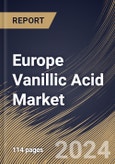In the Vanillic Acid market, a purity level of 98% signifies a high-quality product that meets the needs of various industries. With a purity of 98%, Vanillic Acid offers reliability and effectiveness in applications ranging from food and beverage to pharmaceuticals and cosmetics. Thus, the Germany market would consume 1,008.8 tonnes of 98% pure Vanillic Acid by 2031.
The Germany market dominated the Europe Vanillic Acid Market by Country in 2023, and would continue to be a dominant market till 2031; thereby, achieving a market value of $1,643.8 million by 2031. The UK market is experiencing a CAGR of 1.3% during (2024 - 2031). Additionally, The France market would exhibit a CAGR of 2.1% during (2024 - 2031).
It is a compound commonly found in vanilla beans and certain other plants. It has applications in various industries including food, cosmetics, and pharmaceuticals. In the food industry, it is used as a flavoring agent and preservative, while in cosmetics, it can be found in skincare and haircare products. Additionally, it has potential pharmaceutical uses due to its antioxidant properties.
Adoption trends in the market reflect the evolving preferences of consumers, advancements in technology, regulatory changes, and emerging applications across various industries. For example, with increasing health and wellness awareness, consumers seek products formulated with natural and clean-label ingredients. It is derived from natural sources such as vanillin, lignin, and microbial fermentation, aligns with this trend. Manufacturers respond to consumer preferences by incorporating vanillic acid into food, fragrance, and personal care products as a natural alternative to synthetic additives and preservatives.
Europe is also renowned for its thriving fragrance and perfume industry. With its sweet, vanilla-like aroma, it is a valuable ingredient in perfume and fragrance formulations. As European consumers seek high-quality fragrances with unique scent profiles, the demand for vanillic acid as a fragrance enhancer continues to rise. In addition, the growth of the European cosmetics industry drives innovation and product development in the sector. Cosmetic manufacturers continuously seek novel ingredients like vanillic acid to differentiate their products and cater to evolving consumer preferences. Hence, the increasing cosmetics industry in the region is propelling the market’s growth.
Based on Purity, the market is segmented into Purity 98%, Purity 99%, and Others. Based on Application, the market is segmented into Flavors & Fragrances, Pharmaceutical Intermediates, and Others. Based on countries, the market is segmented into Germany, UK, France, Russia, Spain, Italy, and Rest of Europe.
List of Key Companies Profiled
- Solvay SA
- Lanxess AG
- Parchem Fine and Specialty Chemicals, Inc.
- Biosynth AG (Carbosynth Ltd.)
- Cayman Chemical Company, Inc.
- Merck Millipore (Merck Group)
- Tokyo Chemical Industry Co., Ltd.
- Otto Chemie Pvt. Ltd.
- Santa Cruz Biotechnology, Inc.
- Spectrum Chemical Mfg. Corp.
Market Report Segmentation
By Purity (Volume, Tonnes, USD Billion, 2020-2031)- Purity 98%
- Purity 99%
- Others
- Flavors & Fragrances
- Pharmaceutical Intermediates
- Others
- Germany
- UK
- France
- Russia
- Spain
- Italy
- Rest of Europe
Table of Contents
Companies Mentioned
- Solvay SA
- Lanxess AG
- Parchem Fine and Specialty Chemicals, Inc.
- Biosynth AG (Carbosynth Ltd.)
- Cayman Chemical Company, Inc.
- Merck Millipore (Merck Group)
- Tokyo Chemical Industry Co., Ltd.
- Otto Chemie Pvt. Ltd.
- Santa Cruz Biotechnology, Inc.
- Spectrum Chemical Mfg. Corp.
Methodology

LOADING...









